climate control Alfa Romeo GT 2009 Owner handbook (in English)
[x] Cancel search | Manufacturer: ALFA ROMEO, Model Year: 2009, Model line: GT, Model: Alfa Romeo GT 2009Pages: 271, PDF Size: 5.34 MB
Page 93 of 271
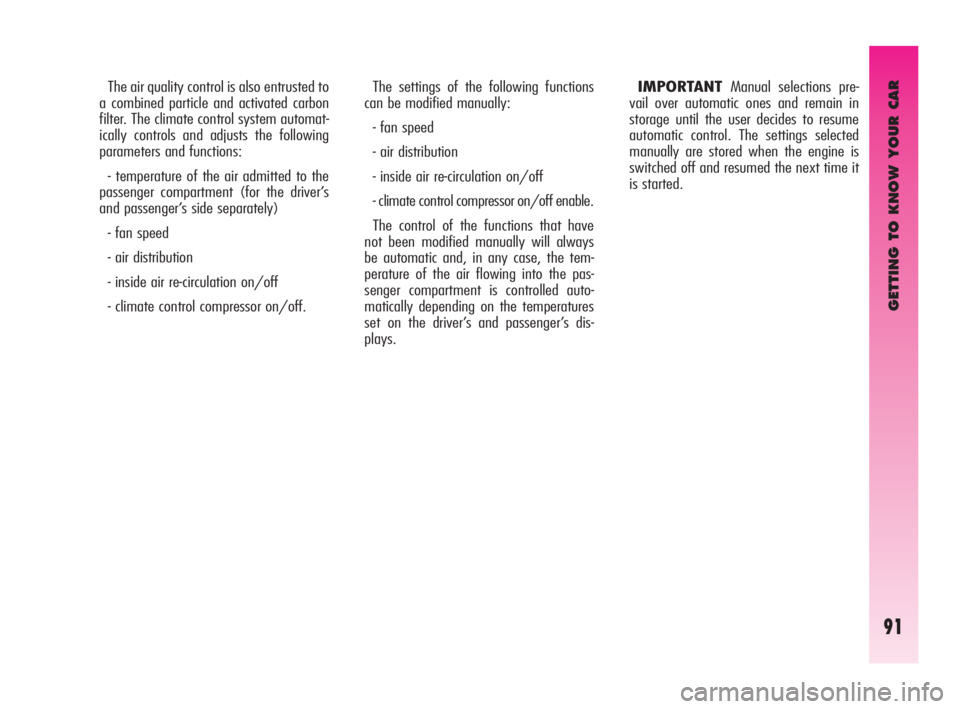
GETTING TO KNOW YOUR CAR
91
The air quality control is also entrusted to
a combined particle and activated carbon
filter. The climate control system automat-
ically controls and adjusts the following
parameters and functions:
- temperature of the air admitted to the
passenger compartment (for the driver’s
and passenger’s side separately)
- fan speed
- air distribution
- inside air re-circulation on/off
- climate control compressor on/off. The settings of the following functions
can be modified manually:
- fan speed
- air distribution
- inside air re-circulation on/off
- climate control compressor on/off enable.
The control of the functions that have
not been modified manually will always
be automatic and, in any case, the tem-
perature of the air flowing into the pas-
senger compartment is controlled auto-
matically depending on the temperatures
set on the driver’s and passenger’s dis-
plays.IMPORTANTManual selections pre-
vail over automatic ones and remain in
storage until the user decides to resume
automatic control. The settings selected
manually are stored when the engine is
switched off and resumed the next time it
is started.
Page 94 of 271
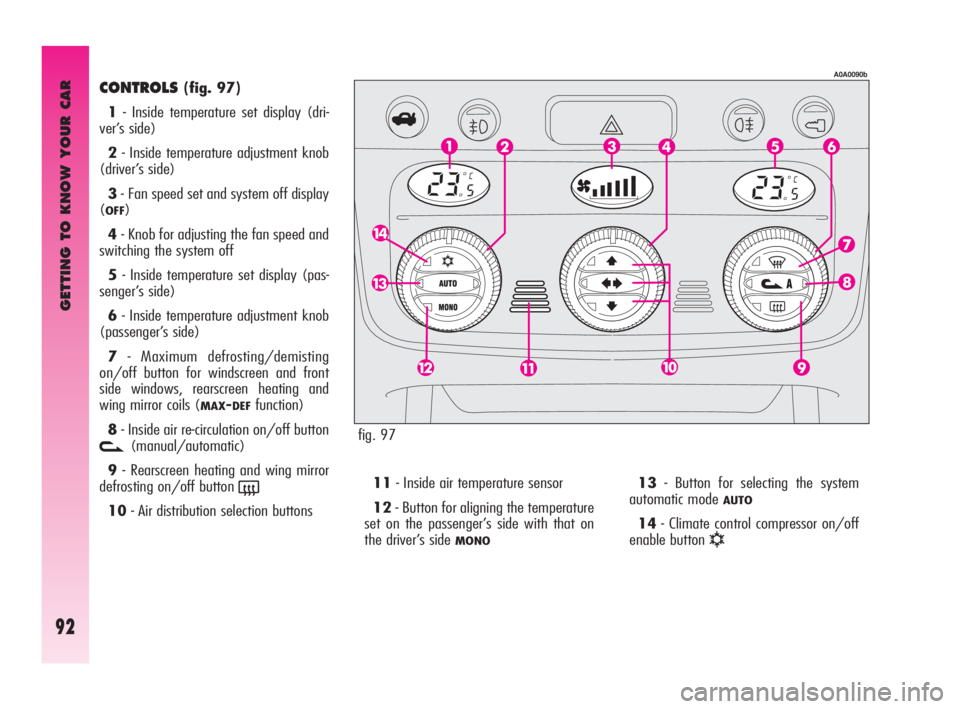
GETTING TO KNOW YOUR CAR
92
CONTROLS(fig. 97)
1- Inside temperature set display (dri-
ver’s side)
2- Inside temperature adjustment knob
(driver’s side)
3- Fan speed set and system off display
(
OFF)
4- Knob for adjusting the fan speed and
switching the system off
5- Inside temperature set display (pas-
senger’s side)
6- Inside temperature adjustment knob
(passenger’s side)
7- Maximum defrosting/demisting
on/off button for windscreen and front
side windows, rearscreen heating and
wing mirror coils (
MAX-DEFfunction)
8- Inside air re-circulation on/off button
v(manual/automatic)
9- Rearscreen heating and wing mirror
defrosting on/off button
(
10- Air distribution selection buttons 11- Inside air temperature sensor
12- Button for aligning the temperature
set on the passenger’s side with that on
the driver’s side
MONO
13- Button for selecting the system
automatic mode
AUTO
14- Climate control compressor on/off
enable button
√
fig. 97
A0A0090b
Page 95 of 271
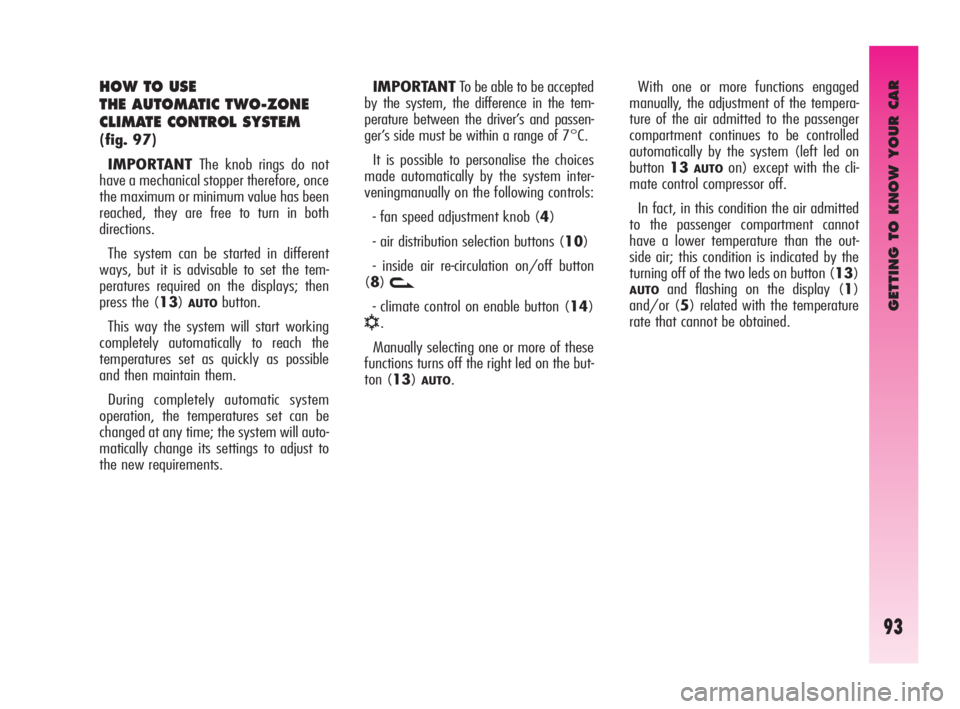
GETTING TO KNOW YOUR CAR
93
HOW TO USE
THE AUTOMATIC TWO-ZONE
CLIMATE CONTROL SYSTEM
(fig. 97)
IMPORTANTThe knob rings do not
have a mechanical stopper therefore, once
the maximum or minimum value has been
reached, they are free to turn in both
directions.
The system can be started in different
ways, but it is advisable to set the tem-
peratures required on the displays; then
press the (13)
AUTObutton.
This way the system will start working
completely automatically to reach the
temperatures set as quickly as possible
and then maintain them.
During completely automatic system
operation, the temperatures set can be
changed at any time; the system will auto-
matically change its settings to adjust to
the new requirements. IMPORTANTTo be able to be accepted
by the system, the difference in the tem-
perature between the driver’s and passen-
ger’s side must be within a range of 7°C.
It is possible to personalise the choices
made automatically by the system inter-
veningmanually on the following controls:
- fan speed adjustment knob (4)
- air distribution selection buttons (10)
- inside air re-circulation on/off button
(8)
v
- climate control on enable button (14)
√.
Manually selecting one or more of these
functions turns off the right led on the but-
ton (13)
AUTO.With one or more functions engaged
manually, the adjustment of the tempera-
ture of the air admitted to the passenger
compartment continues to be controlled
automatically by the system (left led on
button13
AUTOon) except with the cli-
mate control compressor off.
In fact, in this condition the air admitted
to the passenger compartment cannot
have a lower temperature than the out-
side air; this condition is indicated by the
turning off of the two leds on button (13)
AUTOand flashing on the display (1)
and/or (5) related with the temperature
rate that cannot be obtained.
Page 98 of 271
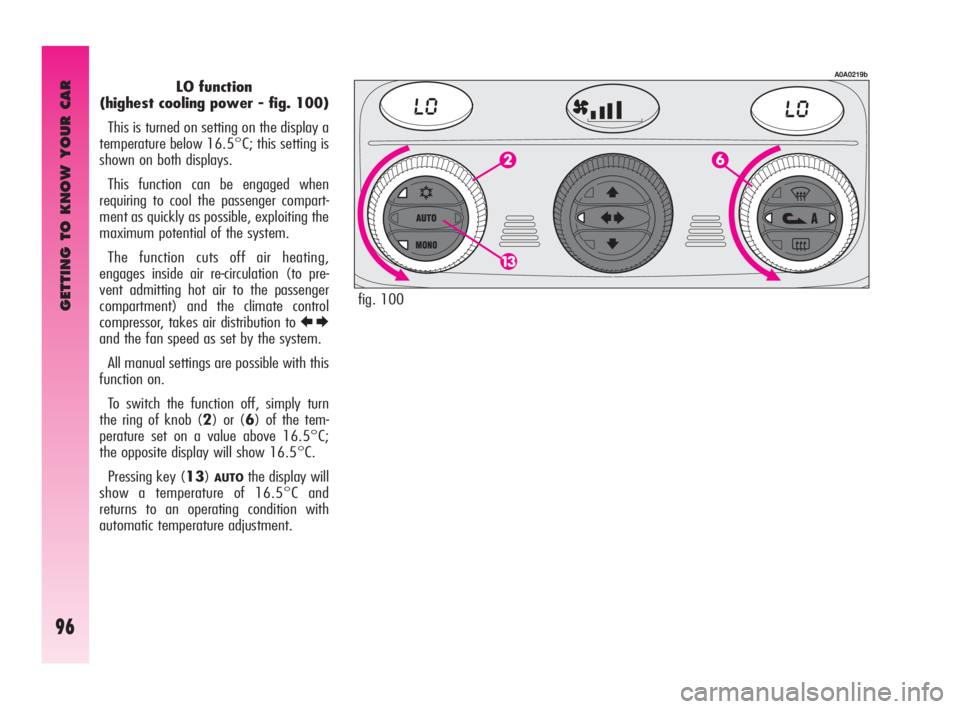
GETTING TO KNOW YOUR CAR
96
LO function
(highest cooling power - fig. 100)
This is turned on setting on the display a
temperature below 16.5°C; this setting is
shown on both displays.
This function can be engaged when
requiring to cool the passenger compart-
ment as quickly as possible, exploiting the
maximum potential of the system.
The function cuts off air heating,
engages inside air re-circulation (to pre-
vent admitting hot air to the passenger
compartment) and the climate control
compressor, takes air distribution to
RE
and the fan speed as set by the system.
All manual settings are possible with this
function on.
To switch the function off, simply turn
the ring of knob (2) or (6) of the tem-
perature set on a value above 16.5°C;
the opposite display will show 16.5°C.
Pressing key (13)
AUTOthe display will
show a temperature of 16.5°C and
returns to an operating condition with
automatic temperature adjustment.
A0A0219b
fig. 100
Page 100 of 271

GETTING TO KNOW YOUR CAR
98
FAN SPEED
ADJUSTMENT KNOB
(fig. 102-103)
Turning the ring of knob (4), clockwise
or counter-clockwise, increases or decreas-
es the speed of the fan, thus the amount
of air admitted to the passenger compart-
ment; the 16 selectable speeds are shown
on a bar (in steps of 3), up to a maximum
of 6 bars lit:
- maximum fan speed = all bars lit;
- minimum fan speed = one bar lit.
The fan can be cut off (all bars off) only
if the climate control compressor has been
switched off pressing button (14)
√. To
restore automatic fan speed control, after a
manual adjustment, press button (13)
AUTO. Completely turning the ring of knob
(4) counter-clockwise switches the system
off, with the following situation: display
(1) off; display (5) off; centre display (3)
with litdisplay
OFFand left led on inside air
re-circulation button (8)
von.
IMPORTANTPressing the inside air
recirculation button (8)
vit is possible
to obtain the inlet of untreated outside air
to the passenger compartment.
To turn the system on again, simply turn
the ring of knob (4) clockwise, or press
any one button, except the inside air re-cir-
culation (8) and rearscreen (9) buttons;
this operation restores all the operating
conditions stored previously.IMPORTANTOn leaving the
OFFcon-
dition, inside air re-circulation
vreturns
to the condition prior to switching off.
A0A0205b
A0A0206bfig. 102
fig. 103
Page 102 of 271
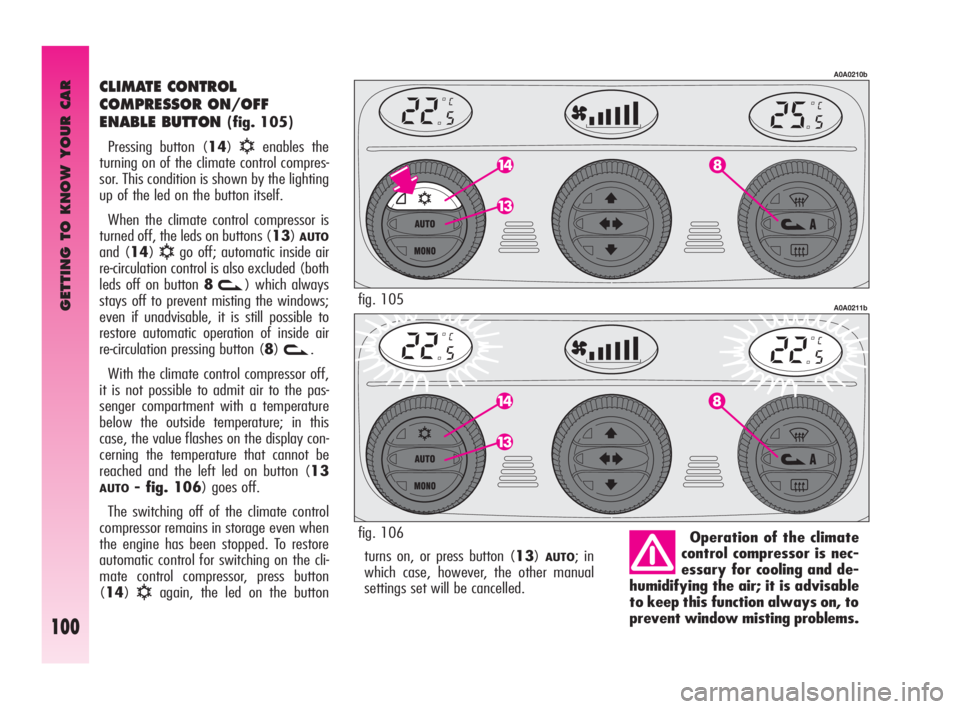
GETTING TO KNOW YOUR CAR
100
turns on, or press button (13)AUTO; in
which case, however, the other manual
settings set will be cancelled.
CLIMATE CONTROL
COMPRESSOR ON/OFF
ENABLE BUTTON
(fig. 105)
Pressing button (14)
√enables the
turning on of the climate control compres-
sor. This condition is shown by the lighting
up of the led on the button itself.
When the climate control compressor is
turned off, the leds on buttons (13)
AUTO
and (14)√go off; automatic inside air
re-circulation control is also excluded (both
leds off on button 8
v) which always
stays off to prevent misting the windows;
even if unadvisable, it is still possible to
restore automatic operation of inside air
re-circulation pressing button (8)
v.
With the climate control compressor off,
it is not possible to admit air to the pas-
senger compartment with a temperature
below the outside temperature; in this
case, the value flashes on the display con-
cerning the temperature that cannot be
reached and the left led on button (13
AUTO- fig. 106) goes off.
The switching off of the climate control
compressor remains in storage even when
the engine has been stopped. To restore
automatic control for switching on the cli-
mate control compressor, press button
(14)
√again, the led on the buttonOperation of the climate
control compressor is nec-
essary for cooling and de-
humidifying the air; it is advisable
to keep this function always on, to
prevent window misting problems.
A0A0210b
A0A0211bfig. 105
fig. 106
Page 103 of 271

GETTING TO KNOW YOUR CAR
101
INSIDE AIR RE-CIRCULATION
ON/OFF BUTTON
(fig. 107)
Inside air re-circulartion is controlled
according to three operating logics:
- automatic control, indicated by the
turning on of the right led on the button;
- forced engagement (inside air re-circu-
lation always on), indicated by the turning
on of the left led on the button (and by
the right led going off at the same time);
- forced switching off (inside air re-circu-
lation always off with air inlet from out-
side), indicated by the turning off of both
leds.
These operating conditions are obtained
pressing in sequence the inside air re-cir-
culation button (8)
v.
When inside air re-circulation is con-
trolled automatically by the system, the
right led on the air re-circulation button
(8)
vstays on all the time and the left
led shows the air re-circulation condition:
on= air re-circulation operating;
off= air re-circulation off.
If inside air re-circulation has been turned
on or off manually, the led on button
(13)
AUTOturns off. In automatic operation , inside air re-cir-
culation is turned automatically when the
antipollution sensor detects the presence
of polluted air, for example in cities,
queues, tunnels and operation of the
windscreen washer (with the typical smell
of spirits). The inside air- re-circula-
tion system makes it pos-
sible to reach the required
“heating” or “cooling” conditions
faster. It is however inadvisable to
use it on rainy/cold days as it
would considerably increase the
possibility of the windows misting
inside, especially if the climate con-
trol system is off.
A0A0212b
With low external tem-
perature the climate con-
trol compressor is unable
to work. It is therefore inadvisable
to use the inside air recirculation
function
vwith low outside tem-
perature as windows may mist
over quickly.
fig. 107
Page 105 of 271
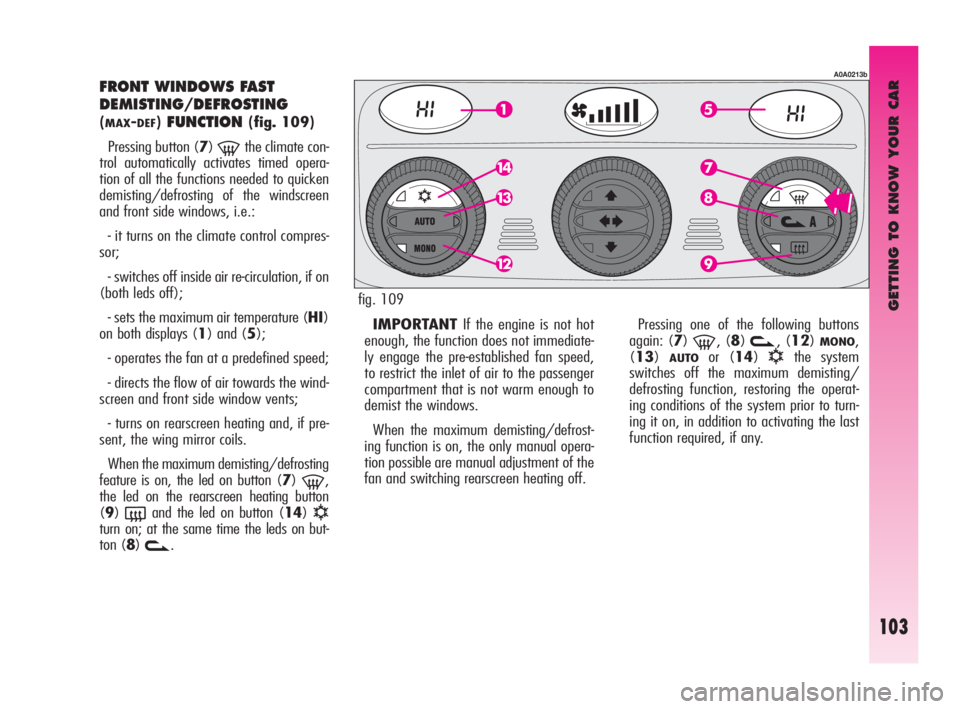
GETTING TO KNOW YOUR CAR
103
FRONT WINDOWS FAST
DEMISTING/DEFROSTING
(MAX-DEF)FUNCTION(fig. 109)
Pressing button (7)
-the climate con-
trol automatically activates timed opera-
tion of all the functions needed to quicken
demisting/defrosting of the windscreen
and front side windows, i.e.:
- it turns on the climate control compres-
sor;
- switches off inside air re-circulation, if on
(both leds off);
- sets the maximum air temperature (HI)
on both displays (1) and (5);
- operates the fan at a predefined speed;
- directs the flow of air towards the wind-
screen and front side window vents;
- turns on rearscreen heating and, if pre-
sent, the wing mirror coils.
When the maximum demisting/defrosting
feature is on, the led on button (7)
-,
the led on the rearscreen heating button
(9)
(and the led on button (14)√turn on; at the same time the leds on but-
ton (8)
v.IMPORTANTIf the engine is not hot
enough, the function does not immediate-
ly engage the pre-established fan speed,
to restrict the inlet of air to the passenger
compartment that is not warm enough to
demist the windows.
When the maximum demisting/defrost-
ing function is on, the only manual opera-
tion possible are manual adjustment of the
fan and switching rearscreen heating off. Pressing one of the following buttons
again: (7)
-, (8)v, (12)MONO,
(13)
AUTOor (14)√the system
switches off the maximum demisting/
defrosting function, restoring the operat-
ing conditions of the system prior to turn-
ing it on, in addition to activating the last
function required, if any.
A0A0213b
fig. 109
Page 172 of 271
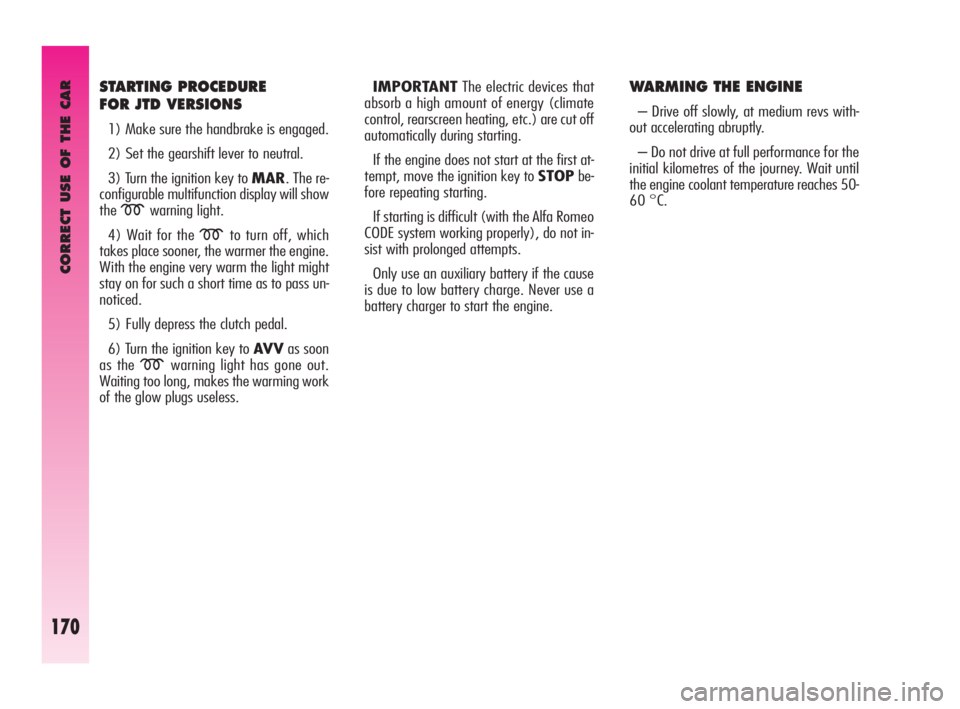
CORRECT USE OF THE CAR
170
STARTING PROCEDURE
FOR JTD VERSIONS
1) Make sure the handbrake is engaged.
2) Set the gearshift lever to neutral.
3) Turn the ignition key to MAR. The re-
configurable multifunction display will show
the
mwarning light.
4) Wait for the
mto turn off, which
takes place sooner, the warmer the engine.
With the engine very warm the light might
stay on for such a short time as to pass un-
noticed.
5) Fully depress the clutch pedal.
6) Turn the ignition key to AV Vas soon
as the
mwarning light has gone out.
Waiting too long, makes the warming work
of the glow plugs useless.IMPORTANTThe electric devices that
absorb a high amount of energy (climate
control, rearscreen heating, etc.) are cut off
automatically during starting.
If the engine does not start at the first at-
tempt, move the ignition key to STOPbe-
fore repeating starting.
If starting is difficult (with the Alfa Romeo
CODE system working properly), do not in-
sist with prolonged attempts.
Only use an auxiliary battery if the cause
is due to low battery charge. Never use a
battery charger to start the engine.
WARMING THE ENGINE
– Drive off slowly, at medium revs with-
out accelerating abruptly.
– Do not drive at full performance for the
initial kilometres of the journey. Wait until
the engine coolant temperature reaches 50-
60 °C.
Page 174 of 271
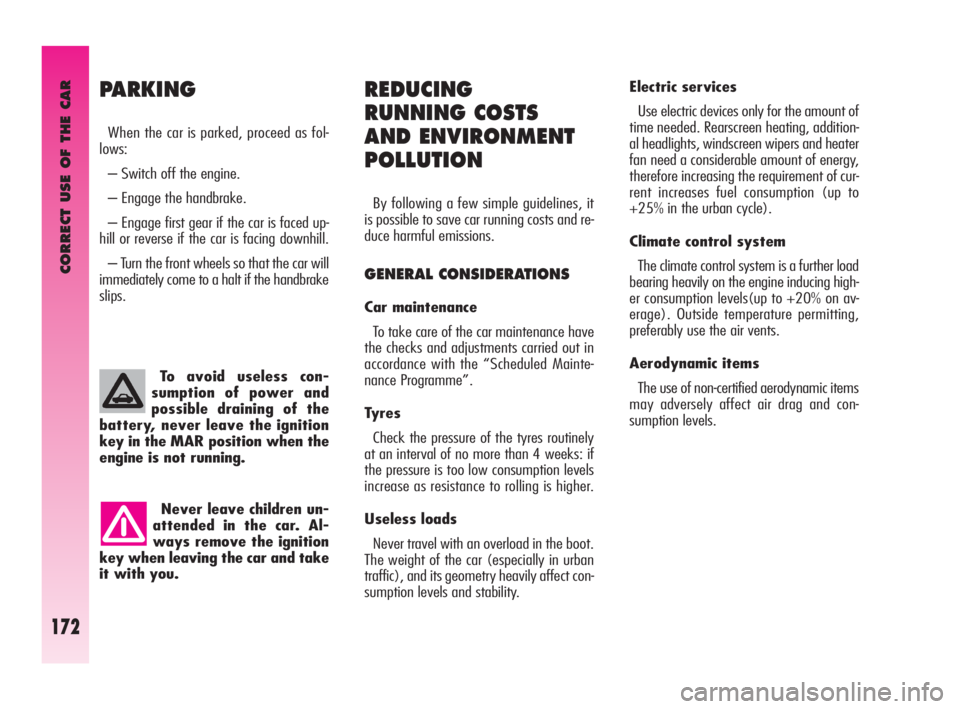
CORRECT USE OF THE CAR
172
Never leave children un-
attended in the car. Al-
ways remove the ignition
key when leaving the car and take
it with you.To avoid useless con-
sumption of power and
possible draining of the
battery, never leave the ignition
key in the MAR position when the
engine is not running.
PARKING
When the car is parked, proceed as fol-
lows:
– Switch off the engine.
– Engage the handbrake.
– Engage first gear if the car is faced up-
hill or reverse if the car is facing downhill.
– Turn the front wheels so that the car will
immediately come to a halt if the handbrake
slips.
REDUCING
RUNNING COSTS
AND ENVIRONMENT
POLLUTION
By following a few simple guidelines, it
is possible to save car running costs and re-
duce harmful emissions.
GENERAL CONSIDERATIONS
Car maintenance
To take care of the car maintenance have
the checks and adjustments carried out in
accordance with the “Scheduled Mainte-
nance Programme”.
Tyres
Check the pressure of the tyres routinely
at an interval of no more than 4 weeks: if
the pressure is too low consumption levels
increase as resistance to rolling is higher.
Useless loads
Never travel with an overload in the boot.
The weight of the car (especially in urban
traffic), and its geometry heavily affect con-
sumption levels and stability.Electric services
Use electric devices only for the amount of
time needed. Rearscreen heating, addition-
al headlights, windscreen wipers and heater
fan need a considerable amount of energy,
therefore increasing the requirement of cur-
rent increases fuel consumption (up to
+25% in the urban cycle).
Climate control system
The climate control system is a further load
bearing heavily on the engine inducing high-
er consumption levels(up to +20% on av-
erage). Outside temperature permitting,
preferably use the air vents.
Aerodynamic items
The use of non-certified aerodynamic items
may adversely affect air drag and con-
sumption levels.